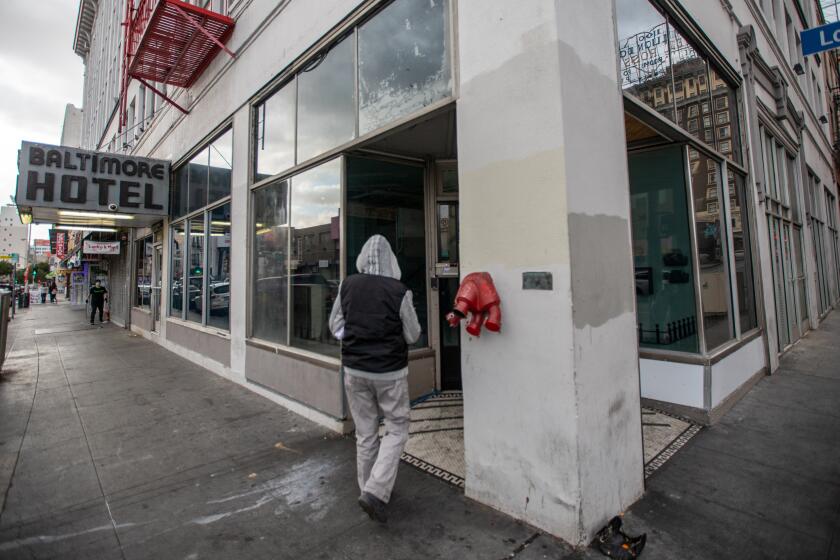State gets two years to cut 43,000 from prisons
California must shrink the population of its teeming prisons by nearly 43,000 inmates over the next two years to meet constitutional standards, a panel of three federal judges ruled Tuesday, ordering the state to come up with a reduction plan by mid-September.
The order cited Gov. Arnold Schwarzenegger’s own words when he proclaimed a state of emergency in the corrections system in 2006 and warned of substantial risk to prison staff, inmates and the general public, saying “immediate action is necessary to prevent death and harm.”
Tuesday’s ruling heightens the stakes for a legislative debate over prisons that will take place later this month. As part of the agreement to close the state’s $26-billion budget gap, the governor and lawmakers agreed to cut $1.2 billion from the prisons budget, but postponed decisions on how to hit that goal.
The governor and most legislative leaders back a plan that would reduce prison populations by as many as 37,000 over the next two years using a combination of early releases, changes in parole policies and shifting of some prisoners to county jails.
Debate on that plan will be contentious, with many Republicans opposed. But the judges’ ruling means that defeating the plan would not only unravel a major piece of the budget agreement but also potentially cede decision-making over prison policies to the federal courts.
Lengthy process
The 185-page opinion follows a trial last year and nearly 14 years of deliberations over lawsuits brought by inmates alleging cruel and unusual punishment, which moved the state case into federal jurisdiction. The opinion accuses the state of fostering “criminogenic” conditions that lead prisoners and parolees to commit more crimes, feeding a cycle of recidivism.
“The constitutional deficiencies in the California prison system’s medical and mental health system cannot be resolved in the absence of a prisoner release order,” the judges concluded.
They stopped short of issuing a release edict, though, giving state officials 45 days to come up with their own plan for reducing overcrowding while observing that alternatives to release, such as building new prisons, were “too distant” and unlikely to be funded.
Atty. Gen. Jerry Brown said the state would comply with the order to produce a plan, but repeated criticism that the judges had ignored significant improvements made in recent years.
He said he doubts the U.S. Supreme Court, to which state officials could appeal any release order, would find that current prison conditions violate the Constitution.
“The courts are ordering the state to come up with a plan to release all these prisoners, but the question is: Which prisoners? Release to what -- halfway houses, GPS monitoring? And what happens when they commit another crime -- do they come back? There’s a lot that is not clear,” Brown said.
Department of Corrections and Rehabilitation Secretary Matthew Cate said he hoped the judges would back down if state officials and lawmakers make progress in reducing the state’s prison population this month, as planned.
The administration’s proposal to cut the inmate population by 37,000 over two years could be approved by the Legislature with a majority vote -- meaning no support would be needed by conservative Republicans who threatened to scuttle last month’s budget deal if prisoner releases were included.
The governor’s plan would allow the state to place on home detention prisoners with less than a year left on their sentences and those who are elderly or infirm. It would also change sentencing and parole rules to reward those who show evidence of rehabilitation.
But Schwarzenegger may be reluctant to use the courts as a hammer to push his plan through. Administration officials have repeatedly said that the court has overstepped its boundaries. The overcrowding problem, Cate said, is a state problem that needs to be fixed by the governor and lawmakers.
“It is not the job of the federal court to do this,” he said.
Noting the legislative session that begins in two weeks, Prison Law Office Director Donald Specter, who brought the prisoners’ suits, said lawmakers now face the choice of being “part of the solution or continuing to be part of the problem.”
Potential win-win
Specter emphasized, as did the judges, that the ruling “doesn’t mean that 40,000 prisoners are going to walk out of prison tomorrow.”
“If done right, this could be a win-win situation for the entire state, as the prisons will be safer for my clients and the staff who work there, taxpayers will save hundreds of millions of dollars a year and communities will be safer as a result,” Specter said, pointing to the judges’ opinion that prison conditions contribute to repeat offenses.
The judges capped the prison population at no more than 137% of the designed capacity of 84,000. That would mean release of 42,920 inmates to meet the population ceiling of 115,080.
Some lawmakers welcomed the ruling while others vowed to fight it.
“It’s frankly a day of reckoning for those who have pushed for constant sentence enhancements, who would decimate rehabilitation programs and who oppose revenues to support state services,” said Assembly Speaker Karen Bass (D-Los Angeles), alluding to Republican lawmakers’ conflicting efforts to be tough on crime while cutting spending.
“Today’s decision by the three-judge panel is a nightmare come true for California families,” countered Assembly Minority Leader Sam Blakeslee of San Luis Obispo. “Any fair-minded court will see there is no way to reduce our prison population by nearly 43,000 without letting out some very dangerous criminals onto our streets and into our neighborhoods.”
The judges pointedly rejected any notion that conditions have improved. Citing testimony during last year’s trial by some of the nation’s foremost prison administrators, the judges said the experts reported “they have never previously witnessed such appalling prison conditions.”
Until overcrowding is reduced, the state will be unable to provide “constitutionally compliant care,” concluded the panel comprised of U.S. District Judges Thelton Henderson and Lawrence Karlton, and U.S. 9th Circuit Judge Stephen Reinhardt.
The judges said overcrowding at prison reception centers approaches three times designed capacity, frustrating prison intake officials’ ability to identify incoming prisoners with medical or mental health problems.
Overcrowding has led to conditions that contribute to the spread of disease, require increased use of lockdowns to control inmates, and impede authorities’ ability to provide essential healthcare, the judges said. It also “worsens many of the risk factors for suicide among inmates and increases the prevalence and acuity of mental illness,” they added.
Conditions are “often dangerous, and on many occasions fatal,” the judges said, alluding to reports that California inmates die of treatable or avoidable illnesses at the rate of one per week.
Henderson, a judge of the U.S. District Court for Northern California, seized oversight of the prison healthcare network in 2006 and appointed a receiver to fix the deficiencies.
J. Clark Kelso, the receiver, said in a recent interview that his staff was making progress on a daunting array of projects but that significant improvements remain at least a year away. He plans to computerize inmate medical records, replace a deficient pharmacy operation, build at least $2 billion worth of hospitals and upgrade existing ones.
--
Times staff writers Evan Halper and Patrick McGreevy in Sacramento contributed to this report.
More to Read
Get the L.A. Times Politics newsletter
Deeply reported insights into legislation, politics and policy from Sacramento, Washington and beyond. In your inbox three times per week.
You may occasionally receive promotional content from the Los Angeles Times.







